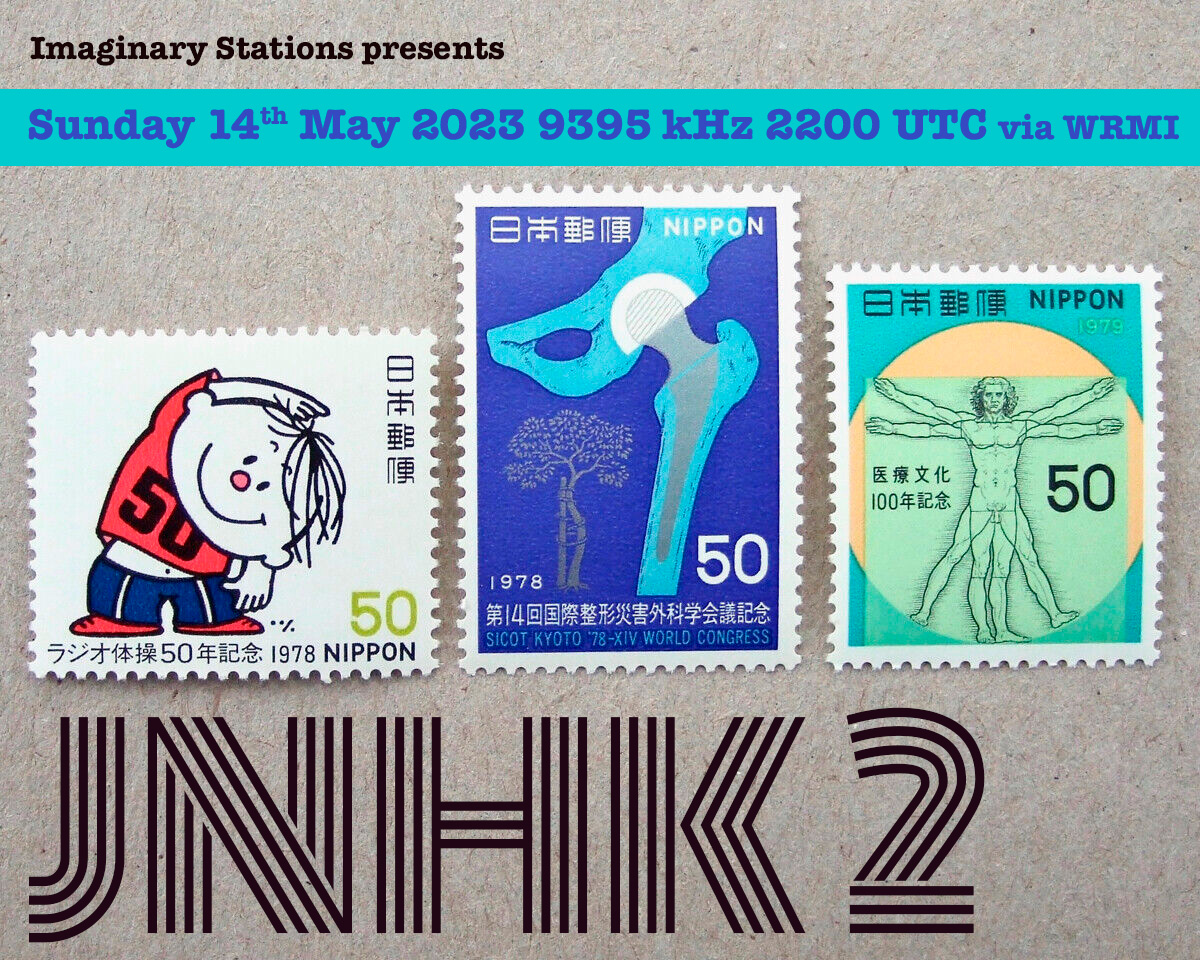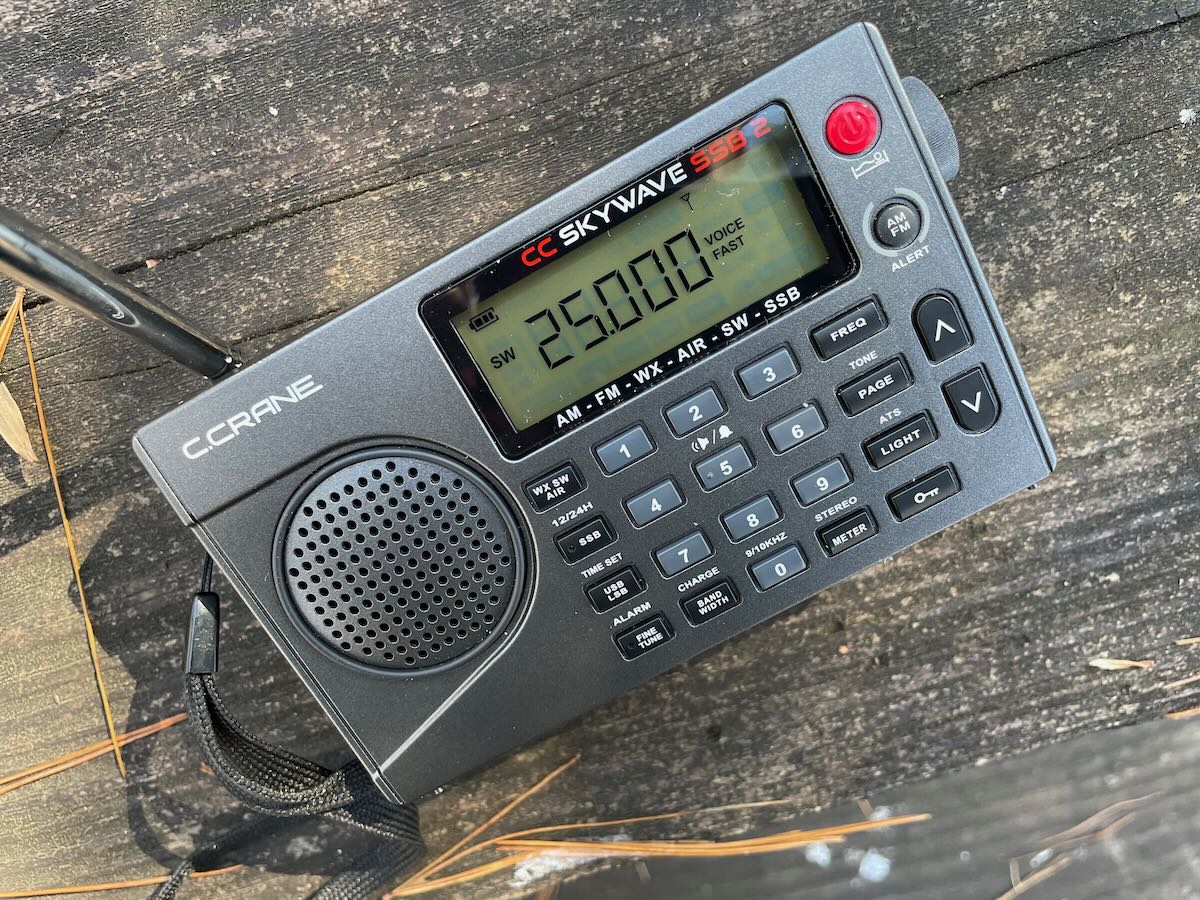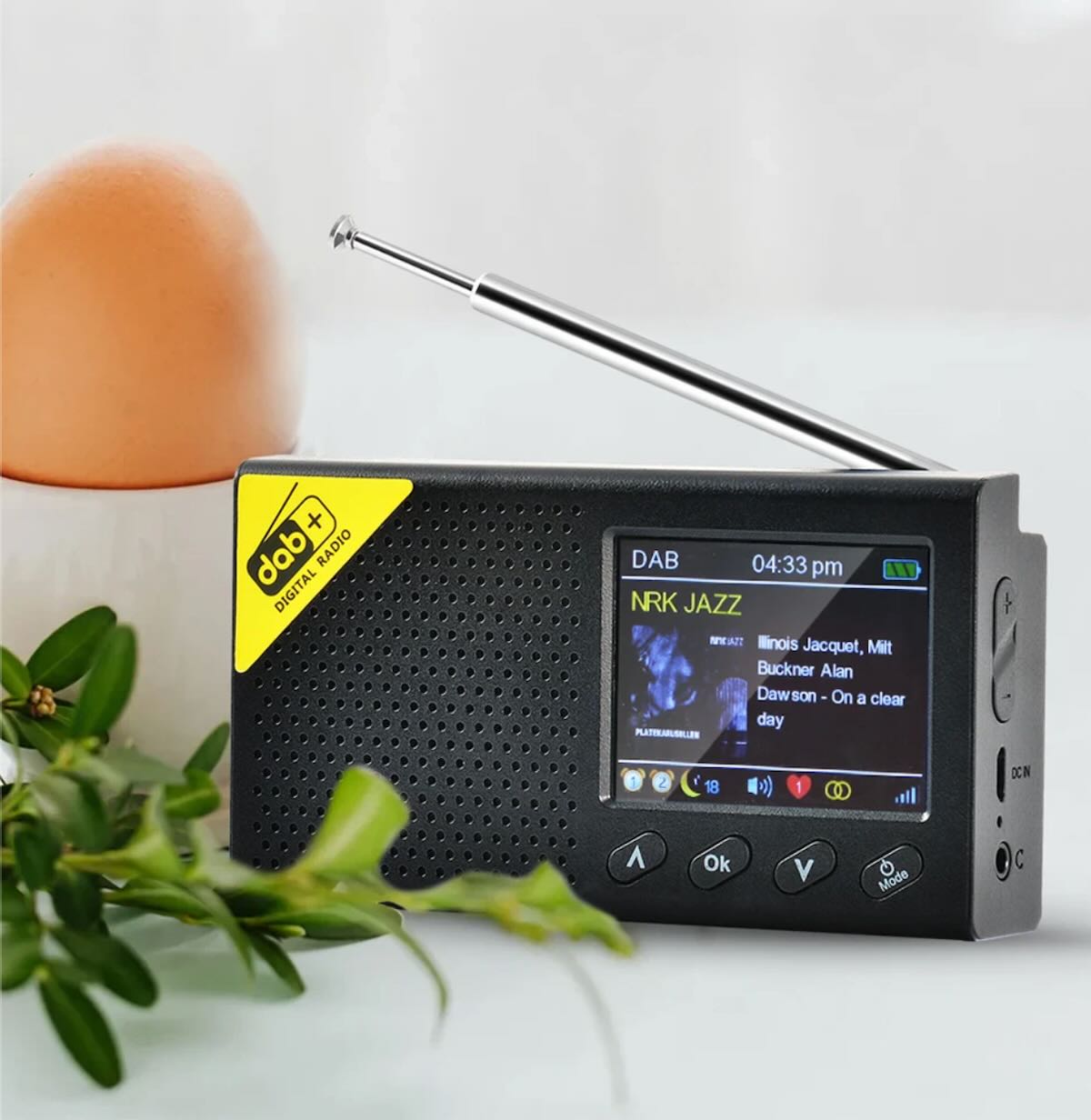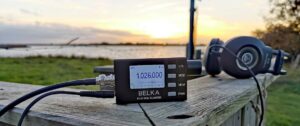 Hi SWLing Post lounge community, Fastradioburst23 here letting you know about the next Imaginary Stations transmission JNHK 3 to be broadcast this Sunday 21st May 2023 at 2200 UTC on 9395 kHz via the services of WRMI. After our well received broadcast last week (thank you to all who got in touch) featuring some recordings of radio in Japan, this week we will feature some Japanese related music. Tune in and enjoy! First-time listeners are more than welcome to send reception reports to [email protected] and to check out our old shows here.
Hi SWLing Post lounge community, Fastradioburst23 here letting you know about the next Imaginary Stations transmission JNHK 3 to be broadcast this Sunday 21st May 2023 at 2200 UTC on 9395 kHz via the services of WRMI. After our well received broadcast last week (thank you to all who got in touch) featuring some recordings of radio in Japan, this week we will feature some Japanese related music. Tune in and enjoy! First-time listeners are more than welcome to send reception reports to [email protected] and to check out our old shows here.
Category Archives: Guest Posts
JNHK2 on WRMI this Sunday
Happy Friday SWLing Post lounge community, Fastradioburst23 here letting you know about our special Imaginary Stations JNHK 2 broadcast which will be aired on Sunday 14th May 2023 at 2200 UTC on 9395 kHz via the services of WRMI. The broadcast features some excellent recordings of Japanese radio from our long-time listener Takuji Sahara from Tokyo. Tune in and sample what’s to be found on the radio dial in Japan. In the words of one of the Imaginary Stations crew “It’s great to know radio is alive and well in Japan.”
Jack examines the C.Crane CC Skywave SSB 2
Many thanks to SWLing Post contributor, Jack Kratoville, who shares the following guest review:
CC Skywave SSB 2: Thoughts and impressions
by Jack Kratoville
I had no intention of purchasing this radio. I already own two of the original Skywaves and, not big into Ham communications, saw little need for the upgrade. But as I was looking at the new SSB 2, my wife walked by and said, “Don’t you already have that one?” I told her it was the updated model and it’s on sale. “You should get it,” she replied. Sometimes it is best to listen to your wife.
My curiosity in the SSB 2 was the “slightly improved” audio and other updated features. It was shipped to my home for $149 complete and I eagerly opened the box. Putting it through the initial paces, I was highly disappointed. Some buttons didn’t work, and the “slightly improved” audio was harsher than the original. It was going back. In a final desperation, I stuck a paper clip in the reset hole and all functions came to life. While I still wasn’t impressed with the overall audio, I would spend more time with it. I’ll address the audio later, but let’s look at what this radio was intended for and how it stacks up to that challenge. This is a communication device, designed specifically for people looking for interesting and far away signals. As far as I can tell, it’s the only radio with “SSB” in its name – so let’s start there.
I have the Digitech AR1780 and the Eton Executive Satellit with SSB capability. I’ve explored both upper and lower sidebands on both. It always seems like too much work; pressing multiple buttons multiple times adding that the Digitech is a notoriously slow scanner. I enjoy them both, but SSB seems like an afterthought. The Skywave SSB 2 is far easier to track down and tune in signals. CCrane includes some tips in the booklet, and I find myself hunting for Ham conversations almost nightly. I haven’t had to attach an external antenna as of yet as I find something without them. If the primary purpose of this radio is to bring a capable SSB portable to your pocket on any adventure, CCrane has scored big. I’m still not a hard core listener, but this radio is very satisfying and I tend to check out the side bands much more frequently.
Next up is the SW band. The SSB2 has a longer antenna and I think it serves well pulling in more distant signals. First thing I noticed is that the SSB2 scans slower than the original Skywave. Perhaps this is due to the ability to detect single side band signals, but I’m not so sure. The original is quite speedy, the SSB 2 seems more normal. The best features are the external antenna options and the hardware provided in the box. Wherever you travel, you can easily hook up an antenna directly into the radio, simply using wire that attaches to the accessories in the box. There is a provided reel antenna, so your options are plentiful. I don’t get any overload, but I’m also not on top of any local signals. I have to say, as a communications device, this radio is designed to please.
Aircraft also benefits from a longer whip and external options. I can just get the feed from my local airport (about 5 miles away). The SSB2 gets the airport weather service clearly. There’s an updated scanner that is perfect for monitoring 2-3 signals at a time. This is a big improvement.
The weather band is one of my favorites and have always enjoyed it on the Pocket and Skywave. Here we have one step forward and one back. I understood why the original Skywave didn’t employ the tone switch on WX. There’s not a lot of dynamic audio here. But the SSB2 does which makes it a bit clearer and certainly louder. Very happy with that update, however when I push the presets on the SSB2, nothing! On the original, pushing 1 through 7 moved you to that WX channel. Now you have to slew through signals using the knob or buttons. Why would they omit this? At my home location, I receive 1, 4 & 7 and would simply press the preset I wanted to hear. Losing this capability makes no sense at all.
AM/MX. This band is always a CCrane strength and the SSB2 will not disappoint. Excellent sensitivity, filtering and scanning options makes this a top tier pocket portable.
FM. Better antenna, better reception. I think it’s a hair more sensitive and selective than the original Skywave, but listening to the FM band leads me into my biggest gripe, the audio.
“Slightly Improved” is a way of saying “don’t expect too much.” At first, I was highly disappointed. Even on “Voice,” the FM band sounded shrill and fatiguing. I almost returned it that first day. I decided that it was better to give time and put it through various paces and locations. Here’s my personal assessment. While audio dynamics is as personal as one’s favorite color, I must start by saying they did make a sizeable effort to improve this radio’s sound – to a degree. Excluding FM, the audio is louder and fuller. I would go as far to say it’s a bigger improvement than they give themselves credit for, especially with SW, SSB and WX. But with FM, they could have trimmed that high end 1-2db and it would have been so much better. U.S. FM signals are overprocessed to begin with and this radio highlights that flaw immensely. (The PL-310et does as well, but with slightly better low end to balance the sound). I’ve brought the radio outside, listened to the non-commercial locals and various low key programming – when the high frequencies are more muted, this model sounds much better than the original. OK, admittedly people are not laying out $160 for this radio to listen to the Zombies, U2 or even Doja Cat, but I don’t think it would have taken much to make this radio audibly more pleasant on all bands.
Where the audio does suffer is at low, low levels. This is not for listening in bed late at night. The improved amplifier has to send more energy to the speaker and that creates a low-level hiss – even when the volume is at zero. This is not a Skywave SSB2 issue, it is an issue with most audio devices trying to pump more into a smaller speaker. Most radios suffer from this to a degree (the original Skywave does not), but some are better than others. The SSB2 is very noticeable.
I honestly feel CCrane put in a big effort trying to please their core base with multiple adjustments to this radio. The screen light is better dispersed. When you shut the unit off, it gives you the time before the light extinguishes. Switching on and off or between bands, the audio fades up and down – better than unexpected loudness. The tuning knob is vastly improved with satisfying clicks and no jumping over frequencies. The volume knob is stiffer with less play. The buttons are better, and the adjusted layout is extremely intuitive. I’m not a huge fan of the current style, but it makes sense. CCrane designed this radio to be more in line with the CC Pocket, giving their portable lineup familiarity between models. I’d prefer the page and memory numbers to remain on screen, but it’s extraneous information. I don’t listen through the earbuds, but they are working on whatever clicking problems occur when switching between bands.
No radio will ever be perfect nor please everyone, but I remain a fan of CCrane. For Ham and SW enthusiasts on the go, this radio is worth your consideration. You can buy cheaper, but you will only get what you pay for. My original Skywave, purchased in 2015, continues working like it did brand new and remains my #1 travel companion. Well, number two behind my wife.
More shortwave supper clubs and less stress
Good day SWLing Post lounge community, Fastradioburst23 here passing on a message about our third episode of the Imaginary Lounge this Sunday 7th May 2023 at 2200 UTC on 9395 kHz via the services of WRMI.
We urge you again to leave the stressful world out there behind and recharge your SWLing AA/LR6 batteries. Loosen the longwire antenna a little, get that favourite silk dressing gown on and swan about with a martini glass in your hand to some fine chilled exotica and relaxing tunes and become at one with the ionosphere. As Sneaky Pete says “Enjoy”.
Guest Post: Review of an affordable, compact DAB+ portable radio
Many thanks to SWLing Post contributor, Mangosman, who shares the following review:
DAB+ digital audio/FM receiver and Bluetooth Audio Player with 2.4 inch LCD Display
by Mangosman
Digital Audio Broadcasting with improved audio compression and error correction is called DAB+. I have had this radio for a few years.
Retail in Australia DAB+/FM radios are generally double the price and more. There has only been one model of DAB+/FM/AM radios which is now no longer trading.
This is a size comparison, the sound is very clear and is surprisingly good on music as well, despite having such a small speaker. Even at maximum volume there is no audible noise or distortion. The stereo program HE AAC compressed and FM and Bluetooth and is available on cabled headphones. Such a small speaker cannot produce much in the way of bass, but it is present on headphones. Since DAB+ is a pure digital system, there is, full stereo, no noise as the radiated signal deteriorates, until the receiver mutes when error correction fails. The radio has a 400 mm long telescopic antenna.
On FM this receiver will decode Radio Data System data, I have had more sensitive FM reception.
This is the most sensitive DAB+ receiver I have owned. I am also currently also using two BUSH clock radios. I also have used older headphone radios, but push buttons and headphone sockets haven’t been very reliable.
This screen shows a full colour album cover which can fill the screen and title. Smooth FM is the broadcaster’s name because it is simulcast in some other cities on FM and DAB+. The indicators on this screen are level of battery change, muting, stereo indicator, when decoded and the signal strength. Continue reading
Another cocktail please, my good mixologist
Hi all of the SWLing Post community Fastradioburst23 here again letting you know of our second Imaginary Lounge this coming Sunday 30th April 2023 at 2200 UTC on 9395 kHz via WRMI.
The transmission will be coming live again from the Skybird Supper Club in Paris and there will be free complimentary cocktail for every participant this time (There will be a code given out and an email address to apply for a token that you can use at a cocktail lounge of your choice) . Expect the finest lounge and exotica classics for your listening pleasure yet again. Raise your Collins glass please.
High Noon: Belka MW shootout part 2, with a review of the AFA200C active MW ferrite antenna
High Noon: Belka MW shootout part 2, with a review of the AFA200C active MW ferrite antenna
by 13dka
When I reviewed the updated Belka (gen3, 2022) for its MW/LW performance in October last year, I just wanted to know if it’s any good with just the whip antenna and used the XHDATA D-808 as a reference radio because it’s a Jay Allen 2.5-star average performer on MW and my expectations were not high for MW reception on a short whip. To my surprise that average bar turned out way too low for the Belka!
That was sure asking for a comparison with the most sensitive MW radio I have and gave me hope to use the Belka for ultra-portable MW DXing on the move. The omnidirectional whip doesn’t allow me to null out unwanted co-channel interference though, therefore I wanted to find a reasonably sized loopstick antenna to pair with the Belka. Continue reading








